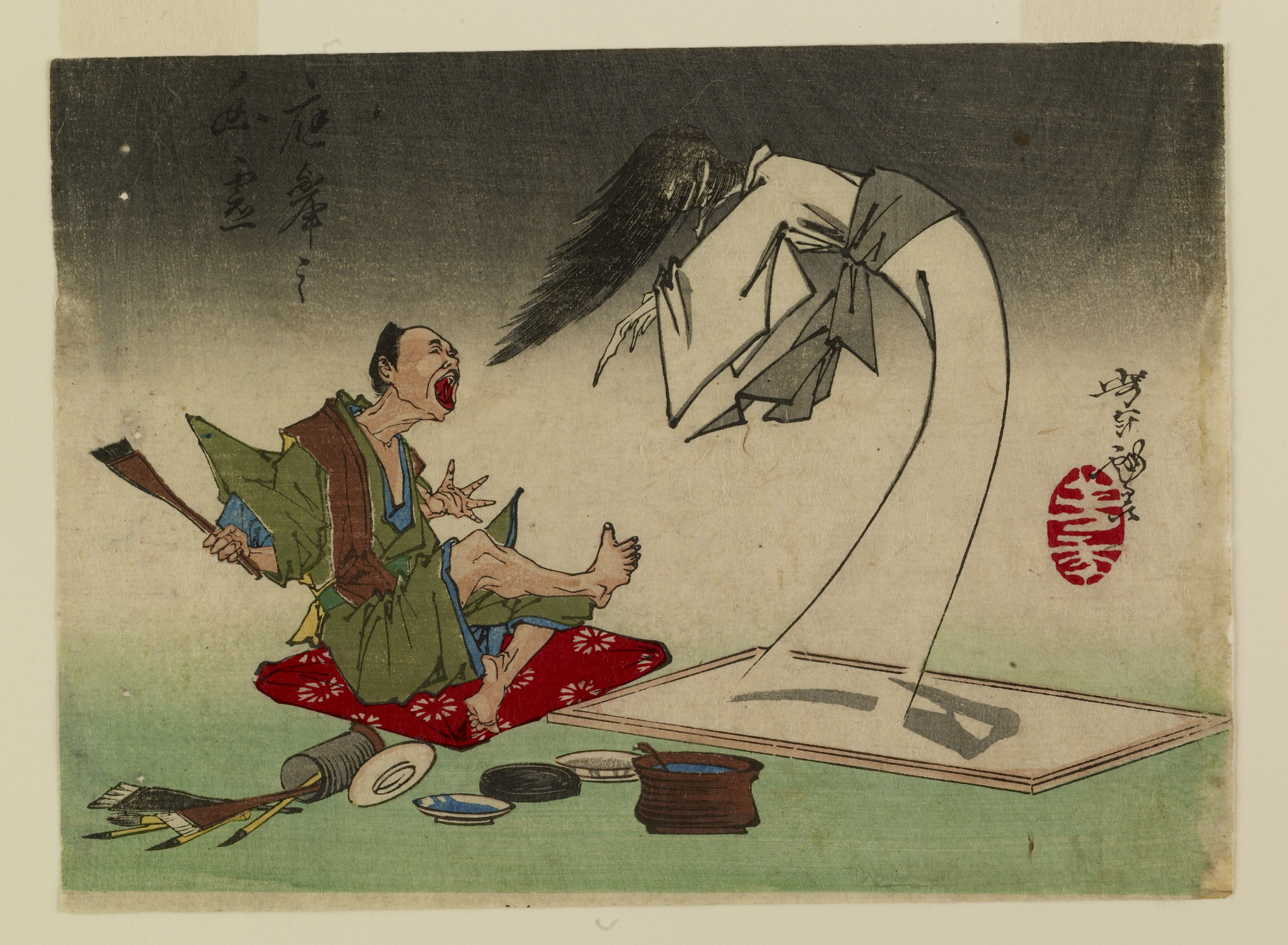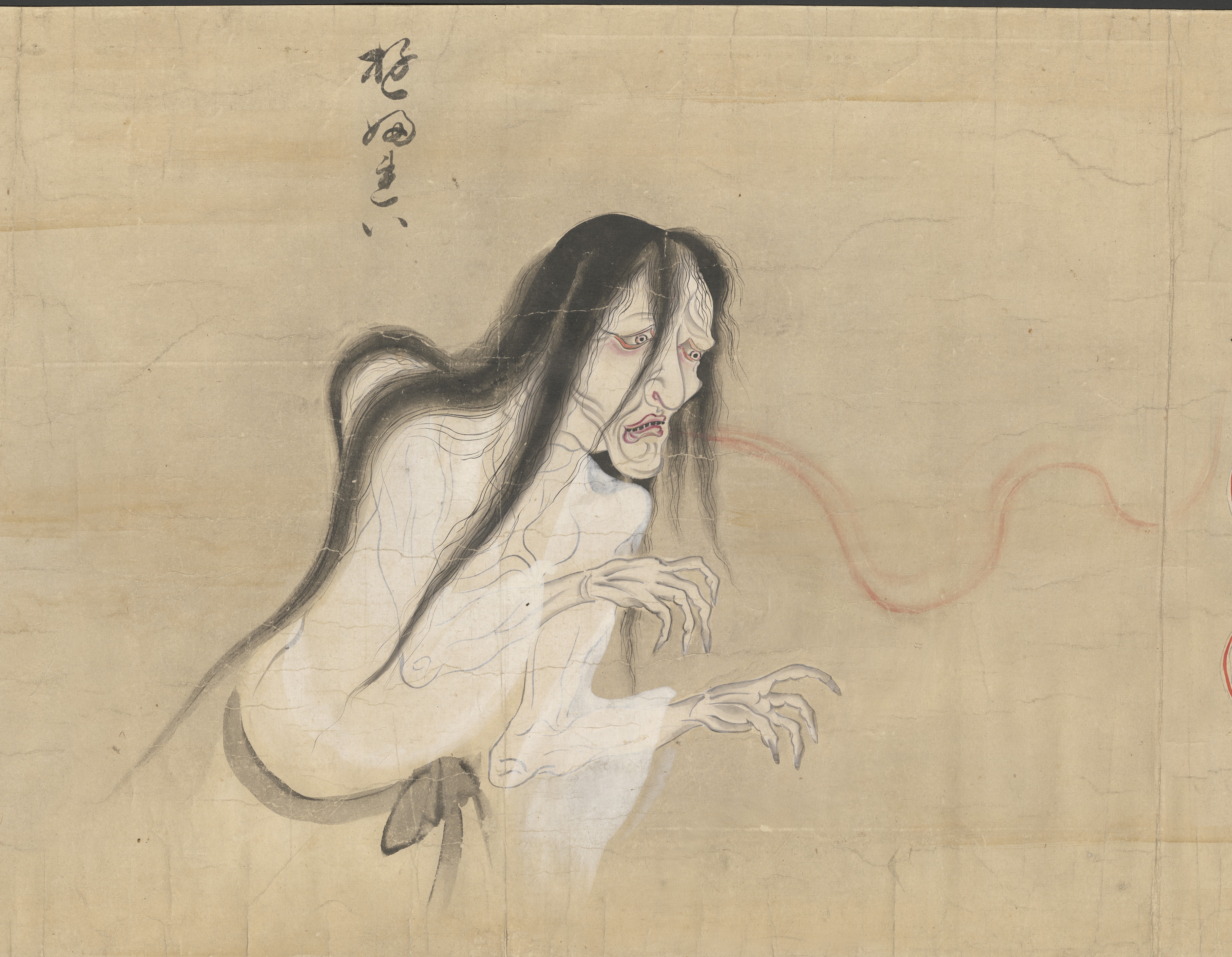|
The Ghost Of Oyuki
is a painting of a female yūrei, (a traditional Japanese ghost), by Maruyama Ōkyo (1733–1795), founder of the Maruyama-Shijō school of painting. According to an inscription on the painting, Okyo had a mistress in the Tominaga Geisha house. She died young and Okyo mourned her death. One night her spirit came to him in a dream. Unable to get her image out of his head, he painted this portrait. This is one of the earliest paintings of a yūrei with the basic late-Edo period ghost characteristics: disheveled hair, white kimono, limp hands, nearly transparent, lack of lower body. References Further reading *Iwasaka, Michiko and Toelken, Barre John Barre Toelken (June 15, 1935 – November 9, 2018) was an award-winning American folklorist, noted for his study of Native American material and oral traditions. Early life and education Barre Toelken was born in Enfield, Massachusetts, to .... ''Ghosts and the Japanese: Cultural Experiences in Japanese Death Legends'', Utah St ... [...More Info...] [...Related Items...] OR: [Wikipedia] [Google] [Baidu] |
Maruyama Ōkyo
, born Maruyama Masataka, was a Japanese artist active in the late 18th century. He moved to Kyoto, during which he studied artworks from Chinese, Japanese and Western sources. A personal style of Western naturalism mixed with Eastern decorative design emerged, and Ōkyo founded the Maruyama school of painting. Although many of his fellow artists criticized his work as too slavishly devoted to natural representation, it proved a success with laypeople. Early career Ōkyo was born into a farming family in Ano-o, in present-day Kameoka, Kyoto. As a teenager, he moved to Kyoto and joined the townspeople (''chōnin'') class. He apprenticed for a toy shop, where he painted the faces onto dolls. The shop began selling European stereoscopes, novelties that when looked into presented the illusion of a three-dimensional image. It was Ōkyo's first look at Western-style perspective,Sullivan 16. and in 1767 he tried his hand at one of the images. He created ''Harbour View'', a small ... [...More Info...] [...Related Items...] OR: [Wikipedia] [Google] [Baidu] |
Yūrei
are figures in Japanese folklore analogous to the Western model of ghosts. The name consists of two kanji, (''yū''), meaning "faint" or "dim" and (''rei''), meaning "soul" or "spirit". Alternative names include , meaning ruined or departed spirit, , meaning dead spirit, or the more encompassing or . Like their Chinese, Korean, and Western counterparts, they are thought to be spirits barred from a peaceful afterlife. Japanese afterlife According to traditional Japanese beliefs, all humans have a spirit or soul called a . When a person dies, the ''reikon'' leaves the body and enters a form of purgatory, where it waits for the proper funeral and post-funeral rites to be performed so that it may join its ancestors. If this is done correctly, the ''reikon'' is believed to be a protector of the living family and to return yearly in August during the Obon Festival to receive thanks. If the person dies, however, in a sudden or violent manner such as murder or suicide, if the pr ... [...More Info...] [...Related Items...] OR: [Wikipedia] [Google] [Baidu] |
Geisha
{{Culture of Japan, Traditions, Geisha {{nihongo, Geisha, 芸者 ({{IPAc-en, ˈ, ɡ, eɪ, ʃ, ə; {{IPA-ja, ɡeːɕa, lang), also known as {{nihongo, , 芸子, geiko (in Kyoto and Kanazawa) or {{nihongo, , 芸妓, geigi, are a class of female Japanese performing artists and entertainers trained in traditional Japanese performing arts styles, such as dance, music and singing, as well as being proficient conversationalists and hosts. Their distinct appearance is characterised by long, trailing kimono, traditional hairstyles and {{transliteration, ja, oshiroi make-up. Geisha entertain at parties known as {{transliteration, ja, ozashiki, often for the entertainment of wealthy clientele, as well as performing on stage and at festivals. Modern geisha are not prostitutes. This misconception originated due to the conflation of Japanese courtesans ({{transliteration, ja, oiran), {{transliteration, ja, oiran reenactors, the extant {{transliteration, ja, tayū, and prostitutes, who ... [...More Info...] [...Related Items...] OR: [Wikipedia] [Google] [Baidu] |
Edo Period
The or is the period between 1603 and 1867 in the history of Japan, when Japan was under the rule of the Tokugawa shogunate and the country's 300 regional '' daimyo''. Emerging from the chaos of the Sengoku period, the Edo period was characterized by economic growth, strict social order, isolationist foreign policies, a stable population, perpetual peace, and popular enjoyment of arts and culture. The period derives its name from Edo (now Tokyo), where on March 24, 1603, the shogunate was officially established by Tokugawa Ieyasu. The period came to an end with the Meiji Restoration and the Boshin War, which restored imperial rule to Japan. Consolidation of the shogunate The Edo period or Tokugawa period is the period between 1603 and 1867 in the history of Japan, when Japan was under the rule of the Tokugawa shogunate and the country's regional '' daimyo''. A revolution took place from the time of the Kamakura shogunate, which existed with the Tennō's court, to the Tok ... [...More Info...] [...Related Items...] OR: [Wikipedia] [Google] [Baidu] |
Kimono
The is a traditional Japanese garment and the national dress of Japan. The kimono is a wrapped-front garment with square sleeves and a rectangular body, and is worn left side wrapped over right, unless the wearer is deceased. The kimono is traditionally worn with a broad sash, called an , and is commonly worn with accessories such as zōri sandals and socks. Kimono have a set method of construction and are typically made from a long, narrow bolt of cloth known as a , though Western-style fabric bolts are also sometimes used. There are different types of kimono for men, women, and children, varying based on the occasion, the season, the wearer's age, and – less commonly in the modern day – the wearer's marital status. Despite the kimono's reputation as a formal and difficult-to-wear garment, there are types of kimono suitable for both formal and informal occasions. The way a person wears their kimono is known as . Though previously been the most common Japanese garm ... [...More Info...] [...Related Items...] OR: [Wikipedia] [Google] [Baidu] |
Toelken, Barre
John Barre Toelken (June 15, 1935 – November 9, 2018) was an award-winning American folklorist, noted for his study of Native American material and oral traditions. Early life and education Barre Toelken was born in Enfield, Massachusetts, to parents John and Sylvia Toelken. The family later moved to Springfield. He began to attend the Utah State University in 1953, where he graduated with a bachelor's degree in English. Toelken completed a master's degree in English literature from Washington State University, followed by a doctorate from the University of Oregon. Career Toelken began his teaching career at the University of Oregon in 1966. During nearly twenty years at the University, Toelken would serve as director for both Folklore and Ethnic Studies and also the Randall V. Mills Archives of Northwest Folklore. Toelken returned to Utah State in 1985: there he would serve as the director of the Folklore Program and co-director of the Fife Folklore Conference. Toelken ... [...More Info...] [...Related Items...] OR: [Wikipedia] [Google] [Baidu] |
Japanese Paintings
Japanese may refer to: * Something from or related to Japan, an island country in East Asia * Japanese language, spoken mainly in Japan * Japanese people, the ethnic group that identifies with Japan through ancestry or culture ** Japanese diaspora, Japanese emigrants and their descendants around the world * Japanese citizens, nationals of Japan under Japanese nationality law ** Foreign-born Japanese, naturalized citizens of Japan * Japanese writing system, consisting of kanji and kana * Japanese cuisine, the food and food culture of Japan See also * List of Japanese people * * Japonica (other) * Japonicum * Japonicus * Japanese studies Japanese studies ( Japanese: ) or Japan studies (sometimes Japanology in Europe), is a sub-field of area studies or East Asian studies involved in social sciences and humanities research on Japan. It incorporates fields such as the study of Japan ... {{disambiguation Language and nationality disambiguation pages ... [...More Info...] [...Related Items...] OR: [Wikipedia] [Google] [Baidu] |
Japanese Ghosts
Japanese may refer to: * Something from or related to Japan, an island country in East Asia * Japanese language, spoken mainly in Japan * Japanese people, the ethnic group that identifies with Japan through ancestry or culture ** Japanese diaspora, Japanese emigrants and their descendants around the world * Japanese citizens, nationals of Japan under Japanese nationality law ** Foreign-born Japanese, naturalized citizens of Japan * Japanese writing system, consisting of kanji and kana * Japanese cuisine, the food and food culture of Japan See also * List of Japanese people * * Japonica (other) * Japonicum * Japonicus * Japanese studies Japanese studies (Japanese: ) or Japan studies (sometimes Japanology in Europe), is a sub-field of area studies or East Asian studies involved in social sciences and humanities research on Japan. It incorporates fields such as the study of Japanese ... {{disambiguation Language and nationality disambiguation pages ... [...More Info...] [...Related Items...] OR: [Wikipedia] [Google] [Baidu] |
Japanese Folklore
Japanese folklore encompasses the informally learned folk traditions of Japan and the Japanese people as expressed in its oral traditions, customs, and material culture. In Japanese, the term is used to describe folklore. The academic study of folklore is known as . Folklorists also employ the term or to refer to the objects and arts they study. Folk religion Men dressed as namahage, wearing ogre-like masks and traditional straw capes (''mino'') make rounds of homes, in an annual ritual of the Oga Peninsula area of the Northeast region. These ogre-men masquerade as kami looking to instill fear in the children who are lazily idling around the fire. This is a particularly colorful example of folk practice still kept alive. A parallel custom is the secretive ritual of the Yaeyama Islands, Okinawa which does not allow itself to be photographed. Many, though increasingly fewer households maintain a kamidana or a small Shinto altar shelf. The Shinto version of the kitchen go ... [...More Info...] [...Related Items...] OR: [Wikipedia] [Google] [Baidu] |




